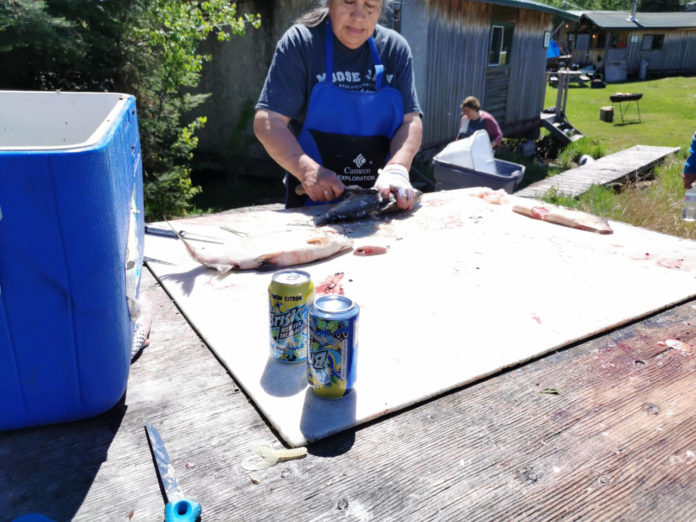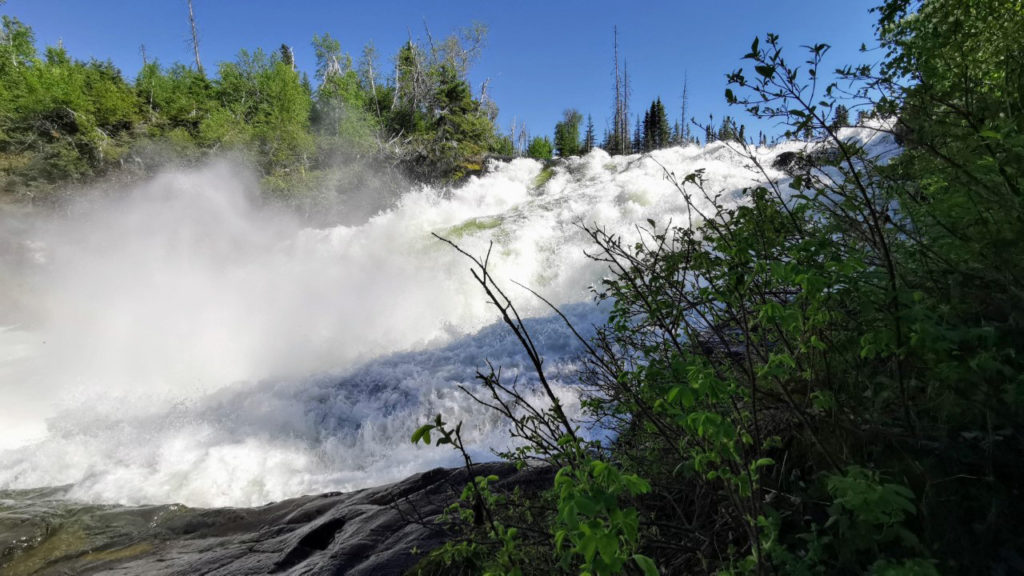
In the beginning of the COVID-19 pandemic, most people stayed at home knowing that there was nowhere to go and very little to do outside their home. Boredom swept the nation by storm as the country all but shutdown. With schools closed and physical distancing strongly encouraged, children were stuck inside, and they didn’t know how long they would have to endure this new life.
Annie McKenzie, an elder from Stanley Mission, didn’t want her grandchildren to have to stay inside their homes every day for an indefinite period, so she took her family to her trapline, which has Jims (sic) Fishing Camp built on it, so she and her grandchildren could stay busy and enjoy the outdoors as it is only her family on the land.
“(I) wanted to bring my grandchildren out here to be healthy out here.” McKenzie said. “So, they could stay active and not be indoors all the time.”
Daily chores of getting wood and chopping it up for fires and fetching water from the lake are enough to keep them busy for part of the day. And then there’s fishing, filleting and cleaning the fish and cooking it, whether it’s smoked, which takes about 8 hours, cooking it over a fire, or having an old-fashioned fish-fry. They eat store-bought food as well, which was brought to the trapline in March in three snowmobiles. Those three sleighs have continued to last the family into June.
The grass still needs to be cut every so often and the various cabins, which patrons use when the fishing camp is in operation, need to be maintained as well. The fishing camp is not in operation this year because of the pandemic. Inter-provincial travel is not advised, and the Canadian border is still closed to Americans. Usually the fishing camp is quite busy during the summer months, with people beginning to call in March and book cabins and rent boats to go fishing and sight-seeing.
Stanley Mission Anglican Church is currently the oldest building in Saskatchewan and there are small cliffs that have thousand-year-old paintings that have stood the elements and time.
Jims Fishing Camp is on a beautiful piece of land and is a just a five-minute hike to Nistowiak falls, one of the highest waterfalls in Saskatchewan. McKenzie is aware that she is lucky to be able to live where she is, but it’s a place that she’s used to.
“(I) feel happy and blessed to be here with the waterfall and this beautiful place.” Mckenzie said. “But it’s nothing new (to me). I grew up on the trapline way down river, so this is my lifestyle.”
McKenzie has been on the current trapline since March 17th and has not left since. When the ice was breaking up, she was alone and every couple of days her grandsons would come up and check in on her, despite the danger of travelling on the ice during spring break-up.
McKenzie used to do a lot of fishing and trapping in her younger days, but as time continues to creep up on her, she relies more on her grandkids for that, although she can still fish off of the dock if she wants to. And though she may not be able to go out and fish, she can still clean and filet the catch of the day with deft, as she showed this writer while teaching how to descale and filet the fish they were preparing to be smoked.
I’m in my early thirties and couldn’t keep up with her, to give somewhat of an image of how quickly she can do something she’s likely been doing most of her life.

Annie McKenzie lives on a trapline just a few minutes from Nistowiak falls, one of the highest waterfalls in Saskatchewan.
Aside from a type 2 diabetes diagnosis 10 years ago, McKenzie has been entirely healthy up to that point, with diabetes being her biggest ailment. She doesn’t eat much store-bought meat, most of the meat she eats is from the land or from the lake.
“(I) plan on staying here (until the pandemic is over) unless I get sick.” McKenzie said on her plans on the staying at her trapline. “Or if there are any community events.”
These days there seems to be few families that have a trapline, although there once was a time that wasn’t the case.
“In the early 80s, like before, when everybody had a trapline, everybody would go out to the traplines. Everybody had a cabin; everybody had a way to get out to the land.” Said Chief Tammy Cook-Searson. “But I think it’s important for us to continue that lifestyle, to teach the importance of getting out on the land, learning how to do stuff on the land, and living out at the trapline, living out on the land and having that connection to the land. Because the land is connected to our language, and the importance of passing on our language and our culture, and traditional values, that way of living. It just like, connects us as families when we’re living out there.”
It’s difficult to get a cell signal when deep in the north in the middle of nowhere, which tends to make people more present. They also have to work together when trapping or carrying a canoe through a portage. And in the evening when the day’s work is done, there’s not much else to do than play games together by the candlelight, creating bonds by those involved. The interconnect ability of nature seems to rub off on humans when completely surrounded by it.
“When I first got off the boat (at Jims Fishing Camp) like, right away I just felt calm.” Cook-Searson said. “And you could just tell like, the amount of work that they put here. Like the family, you can tell they’ve been out here for a few months. Because it shows, because when nobody’s been around in a cabin, y’know, there’s a lot of work to be done.”
The grass on this particular trapline had been freshly cut and the cabins were clean, some with running water. There was no dirt, webs, or insects inside the cabins, even though most of them aren’t being used. The respect this family has for the land and for their business shows.
The feeling of calm upon entering this trapline was mutual, and it may be that it’s remote or maybe it’s that nature is full of life and we can feel that life surrounding us.
“It’s really important for us to get out there.” Said Cook-Searson. “Like just to get out on the land and feel that connection. Even for our language, like for me, I’m fluent. But my kids, they only speak a few words of Cree and it’s something that as a mom, I need to teach my kids how to speak Cree… because the language is so connected to the land. And it’s so descriptive, too, our Cree language. That’s why we’ve been working on our Cree language. We’re almost done the TH dictionary, that late Colin Charles had wrote. But just getting out on the land, like it’s so important.”
When people say that indigenous language is connected to the land, they mean that there are words or phrases that show connection. For example, according to the Cree language, rocks are alive. And according to the Dene language, wolves have spirits.
The Morning Star Lodge had completed a study about Indigenous women with HIV and one correlation they found, was that people who grew up without any ties to culture were more likely to become addicted to substances and showed more risky behaviour without regards to consequences, a finding that has prompted another study to see how culture impacts healing.
McKenzie’s advice for everyone during this time is to get out on the land any way you can, and feel the its healing properties.

